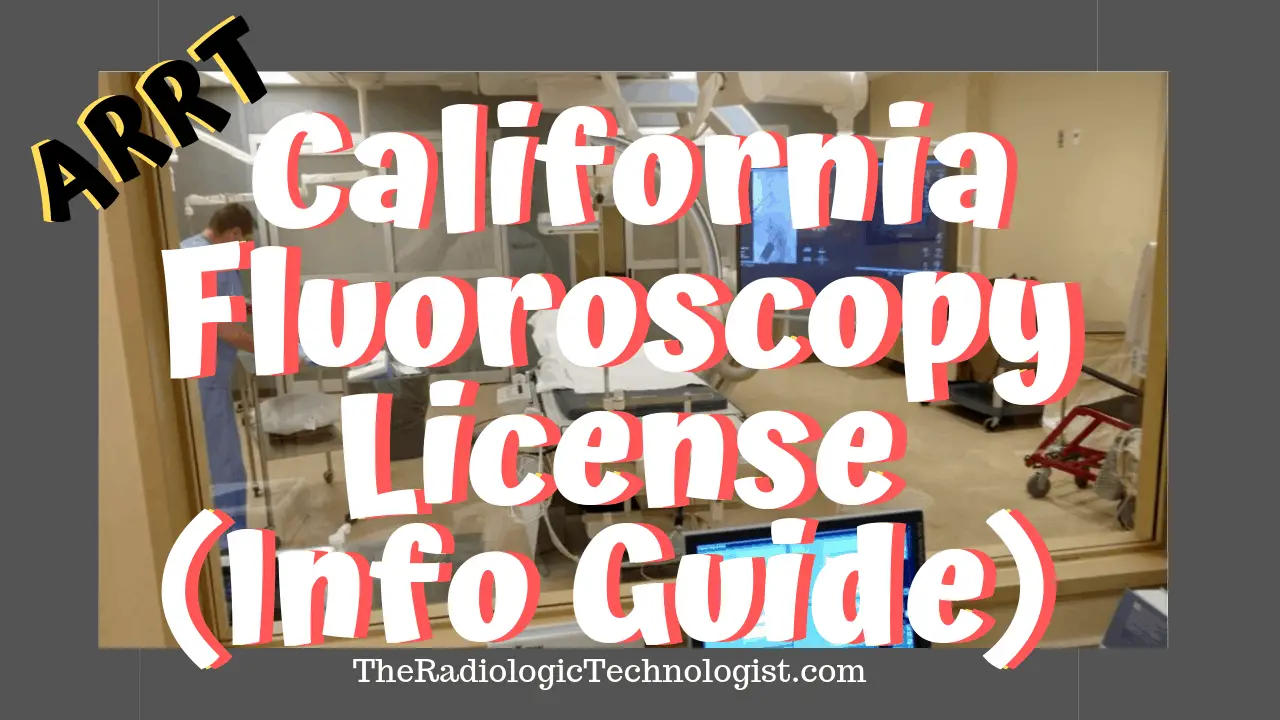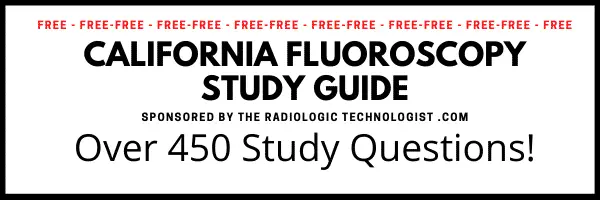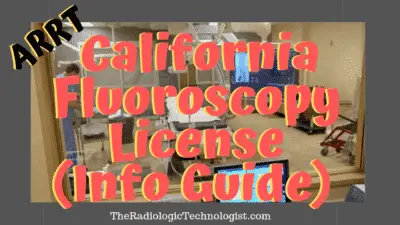
California Fluoroscopy License Exam (ARRT) – Info Guide
In 2013, the Radiological Health Branch of California has adopted a new California fluoroscopy license examination. The new examination is administered by the ARRT.
This new examination will be administered to California candidates who are required to take the examination to either satisfy (1) a radiologic technologist fluoroscopy permit or (2) a fluoroscopy supervisor and operator permit (generally for physicians and PAs.)
ARRT’s Fluoroscopy License Examination is designed for candidates who have relevant foundational qualifications, such as physicians, radiologic technologists, physician’s assistants, and physician extenders.
This also includes education and clinical competency for the specific fluoroscopy procedures they will be performing.
The Fluoroscopy Examination is not intended for limited x-ray machine operators, medical assistants, chiropractic technicians, or other ancillary medical personnel.
Studying for the California fluoroscopy license exam can be stressful but it isn’t impossible. It can be done in as little as 90 days.
The purpose of this exam is to assess the knowledge and cognitive skills that technologists require to perform fluoroscopy.
Why Do I Need a Fluoroscopy License for California, I am ARRT Certified Already!
Here’s one of my favorite explanations from a rad tech forum:
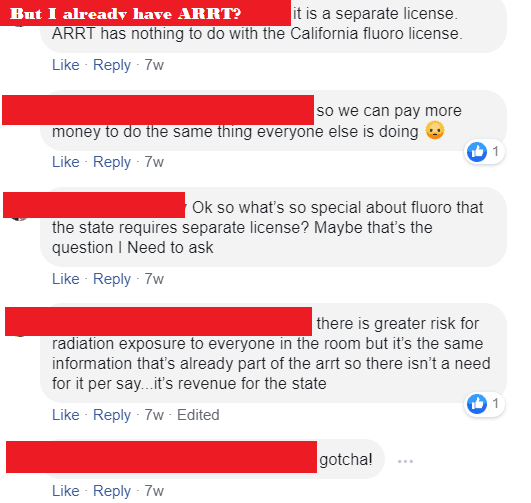
Regardless, options for preparing for the California fluoroscopy license exam are rather vast these days. There are many practice tests with hundreds of questions available online and accessible from any device.
Besides those, you can sign up for many online video-based learning resources too that are designed to support and prepare radiographers, physicians, and practitioners for California fluoroscopy license.
These resources include multiple engaging videos and assessments covering topics that facilitate you in preparing for the exam better, faster, and more easily.
FAQ About the ARRT California Fluoroscopy License Exam
Q: How Long is the California Fluoroscopy License Exam?
You are given 2 hours to complete the exam.
Q: How Many Questions Are on the California Fluoroscopy License Exam?
There are about 90 scored questions, but the total number of test questions varies since ARRT includes non-scored questions as a means of improving future exams.
For example, the test may have 120 questions. You should try your best on every question because you cannot tell which questions are scored or not.
Q: Do I Lose Points if I Answer a Question Incorrectly?
No, your exam score is based on the total number of correct answers, so you should answer every question, even if you have to guess. There is no penalty for guessing.
Q: How Long Until I Know My Score?
This depends on your state licensing agency, which will let you know your examination results. The ARRT does not release the scores.
It could take 4 to 6 weeks before you receive the results of your examination. You will also be given your score by category so that you know which categories you need to work on.
Q: How Many Questions Do I Need to Answer Correctly to Pass?
Total scores are reported on a scale that ranges from 1 to 99. The total scaled score does not equal the number or percentage of questions answered correctly.
A total scaled score of 75 is required to pass the exam. When taking practice exams, it is recommended you get at least 80% consistently to be ready for the real exam.
Q: How Many Days Do I Have to Study for the Exam?
When you receive your acceptance letter to take the exam, you will have a 90-day window to schedule the actual exam. Use as much of that 90-day window that you need to adequately prepare for your exam.
Recommended California Fluoroscopy License Study Material
Additional Online Material Recommended by Technologists
- “Operators who wish to gain a better understanding of conventional and digital fluoroscopy, QA/QC standards, regulations and more!”
- “Our practice exams address the new California fluoroscopy exam. We have carefully reviewed the Conson category and have developed questions, answers rational to provide the candidate with the most up-to-date information.”
- The membership fee is $29.99 per month for complete access to the study material.
What I like about Rayos Education
Here are just some of the credentials of their staff who create the study material:
- Serving on the board of directors for one of the state’s preeminent radiological technologist society.
- Serving as an educational advisor for two radiology programs in California.
- Remember, radiologic technology educators of California.
- Co-chair, committee of clinical education for a trauma hospital in Northern California.
- Numerous written publications in Advance Imaging Magazine.
FluoroPrep (and their Facebook page)
- 100% Money back guarantee that you’ll pass or get a full refund
- Physician reviewed exam questions ensure accuracy
- Access anywhere you have an internet connection, on any device
- Frequently used by ARRT licensed Rad Techs
All these courses and subjects can be taken at your convenience from any computer with internet access.
In case you are not interested in an online course and looking for an economical option, get a book instead. Books like Radiography PREP Program (7th Edition) are great if you are studying for your ARRT exam. They cover every topic that ARRT says will be on the registry test.
Learn How To Study Smarter
When it comes to studying for the California fluoroscopy license, it is important to study smarter, not harder.
You don’t need to memorize everything from every source before the big day. I know studying everything seems better but spending all that time does not necessarily assist in passing this exam. Plus, most people don’t have enough time due to their job requirements.
Your goal should be to study efficiently and only study the key subjects to increase your test scores.
When I assessed the 5th Edition of the Syllabus on the Fluoroscopy of Radiation Protection, it appears that an experienced and professional radiographer can study and answer those questions in detail. There won’t be any confusion and frustration in the concepts. You should receive an updated syllabus after your application is completed.
(Update: I found a link to the 6th Edition of the Syllabus on the Fluoroscopy of Radiation Protection here. )
On the other hand, for a beginner without any experience, some fluoroscopy topics can be confusing. It would be tough to provide detailed feedback with an explanation.
New graduates from accredited radiography programs made need to study a little bit more given the lack of work experience.
Exam Content Outline on the California Fluoroscopy License Exam
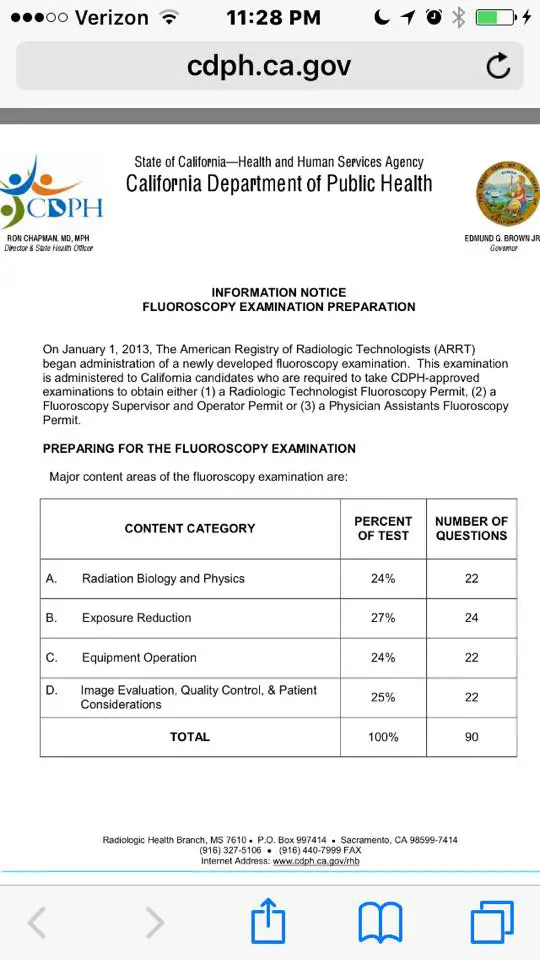
These are the Fluoroscopy Exam categories and the estimated number of scored questions for each. Keep in mind that there are likely a number of non-scored questions on the actual exam.
Understanding key subjects and concepts help you in identifying the correct answers. When you focus on the key subjects, the confusion begins to lessen and the study time required starts to plummet.
For studying purposes, the best thing you can do is to divide the whole content into three main categories:
- Patient Care
- Safety
- Image Production
Patient Care (9 questions)
Patient Interactions and Management (9 questions)
A. Patient Identification and Procedure Verification
B. Components of Informed Consent
C. Risk versus Benefit
D. Patient Education
1. Explanation
2. Respond to inquiries (not limited to e.g., radiation dose, types of radiation)
E. Procedural Understanding to Reduce Exposure
F. Procedure Radiation Exposure (NCRP #160)
G. Cumulative Dose Education
H. Pregnancy Status (e.g., tests and limitations)
I. Contrast Reactions
1. allergy history (e.g., appropriate pre-medication
2. types of reactions (mild to severe)
J. Patient Record Information
1. patient dose/technical factors
2. Adverse reactions
3. picture archiving and communication systems (PACS)
4. hospital information systems (HIS)
5. radiology information systems (RIS)
6. Electronic medical record (EMR) or electronic health record (EHR) systems
K. Standards of Care
L. HIPAA
Safety (46 questions)
Radiation Physics and Radiobiology (22 questions)
A. Radiation Physics
1. photon interactions with matter
a. Compton effect
b. photoelectric absorption
c. coherent (classical) scatter
d. attenuation by various tissues
2. x-ray production
a. source of free electrons (e.g., thermionic emission)
b. acceleration of electrons
c. focusing of electrons
d. deceleration of electrons
e. target interaction (e.g., x-ray spectrum)
3. x-ray beam
a. frequency and wavelength
b. beam characteristics
c. scatter
d. inverse square law
e. fundamental properties (e.g., travel in straight lines, ionize matter)
B. Radiation Biology
1. radiosensitivity
a. dose-response relationships
b. relative tissue radiosensitivity (e.g., LET, RBE)
c. cell survival and recovery
d. oxygen effect
2. somatic effects
a. short-term versus long-term effects
b. acute versus chronic effects
c. carcinogenesis
d. organ and tissue response (e.g., eye, thyroid, breast, bone marrow, skin, gonadal)
3. embryonic and fetal risks
4. genetic effects

2. Radiation Protection (24 questions)
A. Minimizing Patient Exposure
1. exposure factors
a. fluoroscopy time
b. automatic brightness control (ABC)
c. automatic exposure rate control (AERC)
2. shielding
a. rationale for use
b. types
c. placement
3. beam restriction
a. purpose of primary beam restriction
b. collimators
4. filtration
a. effect on skin and organ exposure
b. effect on average beam energy
c. NCRP recommendations (NCRP #102, minimum filtration in useful beam)
5. equipment features
a. last image hold
b. cumulative timer
c. magnification mode
d. dose mode
6. pediatric dose reduction
7. grids
8. receptor positioning
9. patient positioning
a. impact on dose
b. patient immobilization devices
10. dose or time documentation
11. dose area product (DAP) meter
12. air kerma display
13. minimum source-to-skin distance (21 CFR)
B. Personnel Protection
1. sources of radiation exposure
a. primary x-ray beam
b. secondary radiation
c. patient as source
2. basic methods of protection
a. time
b. distance
c. shielding
3. protective devices
a. protective drapes
b. Bucky slot cover
c. shields (e.g., aprons, gloves, eye, face, floating, thyroid)
d. attenuation properties
e. cumulative timer
f. remote-controlled fluoroscopy
4. minimum lead equivalent (NCRP #102)
5. guidelines for fluoroscopy and mobile units (NCRP #102, 21 CFR)
a. fluoroscopy exposure rates (e.g., normal, high-level control)
b. exposure switch guidelines
6. recommendations for personnel monitoring (NCRP #116)
a. occupational exposure
b. public exposure
c. embryo/fetus exposure
d. ALARA and dose equivalent limits
e. evaluation and maintenance of personnel dosimetry records
7. units of measurement
a. absorbed dose
b. dose equivalent
c. exposure
d. effective dose
e. air kerma
8. dosimeters
a. types
b. proper use
Image Production (35 questions)
Equipment Operation (22 questions)
A. Technical Factors
1. mA
2. kVp
3. object-to-image distance (OID)
4. source-to-image distance (SID)
5. focal spot size
6. grids
7. filtration
8. beam restriction
9. automatic brightness control (ABC)
10. automatic exposure rate control (AERC)
11. anatomic alignment
12. exposure compensation
13. magnification mode
14. spot imaging (digital spot)
15. high level control (boost, high dose rate)
16. pulse rate
B. Image Receptors
1. image intensifier
2. flat panel detector
C. Image Display
1. viewing conditions (e.g., luminance, ambient lighting, eye physiology, ergonomics)
2. spatial resolution (e.g., pixel size, pixel pitch
3. contrast resolution/dynamic range
4. DICOM gray scale function
5. brightness and contrast
D. Recording Systems
1. digital subtraction angiography (DSA)
2. image capture
3. spot imaging (digital spot)
E. Imaging Informatics
1. digital imaging and communications in medicine (DICOM)
2. picture archiving and communication systems (PACS)
3. radiology information system (RIS) (e.g., modality worklist)
4. hospital information system (HIS)
5. electronic medical records (EMR) or electronic health records (EHR)
Image Evaluation and Quality Control (13 questions)
A. Digital Image Characteristics
1. spatial resolution (equipment related)
a. sampling frequency
b. detector element size (DEL) (e.g., size, pitch, fill factor)
c. receptor size and matrix size
d. pixel characteristics (e.g., size, pitch)
2. image signal (exposure related)
a. quantum mottle (quantum noise)
b. dynamic range
c. signal to noise ratio (SNR)
d. contrast to noise ratio (CNR)
3. contract resolution (equipment related)
a. bit depth
b. modulation transfer function (MTF)
c. detective quantum efficiency (DQE)
B. Criteria for Image Evaluation
1. demonstration of anatomical structures (e.g., positioning, motion)
2. identification markers (radiographic or electronic) (e.g., anatomical, patient, date)
3. patient considerations (e.g., pathologic conditions)
4. quantum mottle (quantum noise)
5. gross exposure error (e.g., loss of contrast, saturation)
6. contrast
7. spatial resolution
8. distortion (e.g., size, shape)
9. image artifacts (e.g., grid lines, dead pixels, distortion)
C. Recognition and Reporting of Malfunctions
1. quality control
a. display monitor (e.g., grayscale standard display function, luminance
b. shielding accessory testing (e.g., lead apron and glove testing)
c. exposure rate output
d. spot imager
e. image quality (e.g., resolution)
2. recording and reporting of overexposure
Intimidated? Don’t be. There’s an old saying: “The best way to eat an elephant is one bite at a time.” Not that any of us actually EAT elephants. The point is, things that may seem overwhelming or impossible can become achievable if you break them down into smaller steps.
For example, in the patient care and management category, they can ask questions regarding:
- Procedural understanding to reduce exposure.
- Types of reaction (mild to severe).
- Electronic medical record (EMR).
- Different standards of care.
- Patient identification and procedure verification.
The Safety Category has most questions about Radiation Physics and Radiobiology. It is a bit tougher subject compared to Patient Care & Image Production. It has questions related to the following:
- The characteristics of the beam.
- Inverse-square law.
- Source of free electrons in x-ray production.
- Photons interactions with matter.
- Organs and tissue response.
Lastly, Image Production has questions about:
- NCRP recommendations.
- Minimizing patients’ exposure.
- Basic methods of protection.
- The different modes of dose.
- Fluoroscopy exposure rates.
When you break up all the material and focus on these three categories, you cover all fluoroscopy subjects.
How to Apply for the California Fluoroscopy License
The entire process of obtaining the California fluoroscopy license takes about 3-6 months, and it happens in three basic steps.
Step One – Apply for the permit/license at the California Department of Public Health. You can visit their website and download the form.
Step Two – You have to mail in the application with a check for $180. It is not possible to submit the form online (yet).
Step Three – After application, you get a confirmation letter within 1-2 weeks. After receiving the letter, you have 90 days maximum to prepare and take the ARRT administered the exam. You set the date based on the window stated in the letter.
Bear in mind, you can’t apply for the exam if you don’t have a valid California physician, physician assistant or technologist license. It is pertinent to obtain it first, particularly if you are moving from other states. The license from passing this exam is valid for 2 years and it can be renewed without taking another test.
Understand the Testing Center Protocol
It is imperative that you know about the test center environment as it will also give you the self-confidence you need as you approach exam day.
Most test centers provide computerized testing for the ARRT examination. It is highly possible you won’t be alone and other tests will be administered at the same time in the building. The exams I have taken through Pearson Vue do administer different tests in the same room.
There are also some other procedures and rules you need to know.
- Outerwear like an overcoat, hat, or jacket isn’t allowed in the examination room. You will be asked to store them in lockers in the lobby. The exam room temperature is always comfortable. Clothing typically is worn indoors like a sweater or blazer is allowed.
- If there is too much distraction and they aren’t able to provide a noise-free exam environment, request the earplugs. Noise reduction headphones can be provided for your comfort. Personally, I have always opted for the headphones to block out the noise from other test-takers. Without fail, there is always someone in the room with me who has the sniffles… and it drives me nuts! Headphones help a lot.
- Try to arrive at least 30 minutes early before your scheduled appointment. This reduces stress on you and allows ample time to get checked in for your exam.
- The appointment can be forfeited if you arrive late. The test center will report your failure to ARRT and won’t refund the exam fee either. You have to repeat the entire process for new exam eligibility information.
- You will be required to show the official government-issued photo ID. Without proper ID, you won’t be admitted to the center.
These are just a few key points you must keep in mind. The test center personnel also provide you a copy of the ARRT Candidate Rules Agreement. All the key rules are mentioned in this agreement, such as removing jewelry that is wider than 1/4″, keeping all your items in the secure locker, turning off the phone, etc.
Note: if you leave the testing room for more than 10 minutes for personal reasons, the staff will report this incident with ARRT and it can be a trouble for you.
After you have completed check-in procedures, you will be escorted to a computer. The computer will verify your name and present you with the tutorial for a better understanding of the exam. We highly recommend you to spend some time to take the tutorial.
It is kind of an introductory segment that tells you everything about the agreement. Once you read it carefully and accept the terms, the examination session starts. Most questions are in the standard multiple-choice format and you have to choose the best answer.
The exam can ask questions three ways:
- Select Multiple… This format directs you to select all the correct options.
- Sorted List… You have to place the options in the correct sequence.
- Hot Area Items… You put the cursor over the selected area and choose your final answers.
There are some video sections too in which you must watch the video in its entirety and then answer the questions. These videos are often without sound.
After finishing the test, you have the opportunity to go back and review the questions in the remaining time. This part of the examination, we believe, is so important. You can not only correct your mistakes by changing the answers but also calculate the score by counting your right answers.
Lastly, there is an End Review button and an option to take a Survey.
What If You Don’t Pass The Test
You have a limit of three attempts in three years. The three years window starts with the first date of your ARRT exam. If you stay unsuccessful with three exam attempts, your eligibility ends.
In this situation, you have to regain eligibility to apply for the California fluoroscopy license exam, and it can happen only in two ways – Primary Pathway & Post-Primary Pathway.
In the primary pathway, you enroll in and complete the same or a different educational program first (radiography, etc.) You can complete it under the advanced placement option as well. This option is for those who have previous education in the same category and now want to study more than the normal entry point.
In the post-primary pathway, you need to satisfy the clinical experience too with structured education requirements. However, it is necessary to perform clinical experience within two years before you submit the new application for the license exam again.
Conclusion
Earning a California fluoroscopy license from ARRT is challenging but not impossible. Especially, if you have signed up for online video lessons. You can study for the exam and pass it with confidence. Use my proven methods of study techniques and you’ll be fine.
Once you have this license, you become a recognized individual qualified to perform fluoroscopy as a radiographer in California. It is indeed the best way to show your professional standards too.
Resources
- NCRP Report No. 168. Radiation dose management for fluoroscopically-guided interventional medical procedures: National Council on Radiation Protection and Measurements; 2010. Available at: https://ncrponline.org/publications/reports/ncrp-report-168/. Accessed February 26, 2019.
- State of California Department of Public Health. Radiologic Technologist Fluoroscopy Permit Application. Available at: https://www.cdph.ca.gov/CDPH%20Document%20Library/ControlledForms/cdph8218.pdf. Accessed February 26, 2019.
- State of California Department of Public Health. Use of Fluoroscopy Equipment by Physician Assistants. Available at: http://carules.elaws.us/code/t.17_d.1_ch.5_subch.4.5_group4.6. Accessed February 26, 2019.
- State of California Department of Public Health. Information notice on fluoroscopy examination preparation; 2014. Available at: https://www.cdph.ca.gov/Programs/CEH/DRSEM/CDPH%20Document%20Library/RHB/Certification/FluoroPermitExamPreparationNotice.pdf. Accessed February 26, 2019.

